INTRODUCTION
SOURCES OF FOOD
(i)Cereals : These are rich in carbohydrate and thus provide energy.
eg. – Rice, wheat, maize, sorghum, barley, millets.
(ii)Pulses : These are rich in protein and thus helpful for body building.
eg. – Gram, moong, pea, lentil, urd, pigeon pea.
(iii) Oil seed crops :– These are rich in oil and fatty acids.
eg. – Groundnut, sunflower, soyabean, mustard, sesame.
(iv) Vegetable crops : These provide vitamins, minerals along with small quantities of carbohydrate protein and oils.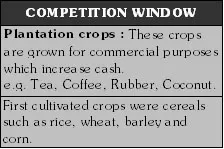
Leaves : Cabbage, spinach, trigonella, lettuce
Roots : Carrot, radish, turnip, sweet potato
Stems : Potato, corms, rhizomes (ginger)
Bulbs : Onion, garlic
Fruits : Tomato, brinjal, gourd, cucumber
Flowers : Cauliflower, bauhinia, banana
(v) Fodder crops : These provide green fodder to the cattle.
eg. – Berseem, sorghum, maize, oat, sudan grass, alfalfa.
1.Crops : Plants of same kind which are grown and cultivated at one place on a large scale are known as crops.
2. Agriculture :– Word agriculture has come from two Latin words, ager meaning field or soil : culture meaning cultivation. Agriculture or farming is the
cultivation of the soil. It includes growing of plant crops and rearing of animals.
* It is an applied biological science which deals with the production of plants and raising of livestock for human use.


3.Basic requirements of agriculture :
DO YOU KNOW?
a) Modern agriculture :– Modern agriculture is a combined effort of art, science and technology to providefood, cloth and shelter to increasing human population.
To improve the efficiency of the agriculture process and increase output following steps are taken:
· Highly efficient tools and machines are made and used.
· Building of dams and canals for irrigation.
· Development of pest resistant and high yielding variety.
· Use of fertilizers and pesticides for nutrition and protection of crop respectively.
b) Sustainable agriculture : The practice of farming and production of maximum agriculture yield through management of natural resources without disturbing
the environment is known as sustainable agriculture.
Review Questions
1. What are zayed crops?
2. What is agriculture?
3. Name the two plantation crops.
4. When are Kharif crops sown?
AGRICUTURE PRACTICES
Activities which are carried out by the farmer to ensure good crop yield in particular sequence till the crop mature at harvest are known as agriculture practices.
(1) Soil preparation : (a) Ploughing (b) Levelling (c) Manuring
(2) Sowing (3) Irrigation (4) Weeding (5) Harvesting (6) Threshing (7) Winnowing (8) Storage.
(1) SOIL PREPERATION Various process are included in it.
(a) Ploughing or Tilling – Process of loosening and turning of the soil is called ploughing or tilling.
Advantages of ploughing :
DO YOU KNOW?
1.Agriculture implements : The tools required for carrying out the activities involved in the cultivation of plants are known as agriculture implements.
2. Plough : It contains triangular iron strip called ploughshare and main part of the plough is a long log of wood called ploughshaft. One end of the shaft is handle
and other end is attached to a beam which is placed on the bulls necks.
One pair of bulls and a man can easily operate the plough.
3. Hoe : This is used for removing weeds and for loosening the soil. It has a long rod of wood or iron. A strong, broad and bent plate of iron is fixed to one of its ends
and works like a blade. It is pulled by animals.
4. Cultivator :Ploughing can also be done by tractor driven cultivator. The use of cultivator saves labour and time.

Cultivator driven by a tractor
(b) Levelling : Tilled soil may have big blocks of soil (crumbs). Crumbs are broken down and soil is levelled with wooden planks or iron leveller, the process
called levelling. Levelling is done for better sowing and irrigation.
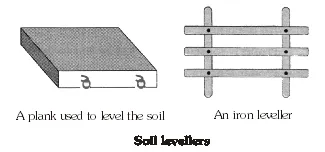
Advantages of levelling :
Review Questions
1. What are the various steps in the preparation of the soil?
2. What are the advantages of turning the soil?
3. What are the advantages of levelling?
4. Why is soil turned and loosened before seeds are sown?
(c) Manuring : Farmers have to add manure to the field to replenish the soil with nutrients, the process known as manuring.
* Manure : These are organic substances, obtained from the decomposition of plant and animal wastes.
* Advantages of manure :
1. It increases the number of friendly microbes.
2. It improves the texture of soil by adding organic matter (humus).
3. It increases soil fertility, water holding capacity and aeration.
4. It reduces soil erosion.
5. It is cheap.
* Disadvantage of manure :
1.They have less amount of nutrients as compared to fertilizers.
2. Manures are bulky and not easy to store and transport.
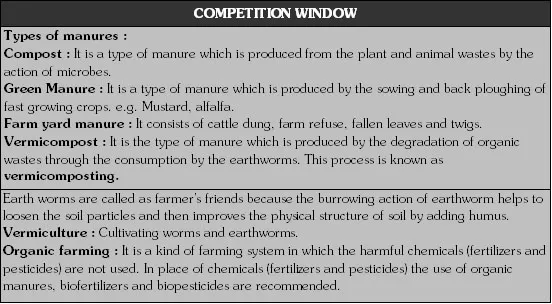
* Fertilizers : These are commercially manufactured inorganic 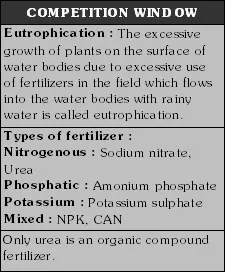
salts containing one or more essential plant nutrients like NPK,
which are used to increase soil fertility.
* Advantages of fertilizers :
1.They are nutrient specific and required in small amounts.
2.They are water soluble and absorbed by the plant easily.
3. They are easy to store and transport.
* Disadvantages of fertilizers :
1.Fertilizers can change the soil structure by killing the soil microbes.
2. Fertilizers can change the chemical composition of soil.
3. Accumulation of fertilizers in water bodies causes eutrophication.
DO YOU KNOW?
Methods for maintaining soil fertility without use of fertilizers
a) Field fallow : The practice of leaving the field uncultivated for a season is called field fallow.
b) Crop rotation : The practice of growing different crops in succession in the same field is called crop rotation.
c) Biofertilizers : Organisms which enrich the soil nutrients due to their biological activities are called biofertilizers. e.g. Rhizobium bacteria, Nostoc and Anabaena (BGA).
d) Body of the living organisms is made of proteins. Proteins are the compounds of nitrogen, carbon, oxygen and hydrogen. Air nitrogen is fixed into compounds
of nitrogen (Nitrogen oxides solution in water) by certain microorganisms. Microorganisms such as Rhizobium (= Bacillus) bacterium is present in the root
nodules of Leguminous plants Bacterium Rhizobium radicicola is capable of fixing air nitrogen. Fixation of nitrogen enriches soil in a natural way.
1. Nitrogen fixation is the process of combining oxygen with nitrogen to form nitrogen compounds such as nitrites (NO2) and nitrates (NO3).
2. Blue green algae are common along drains, wet places and flooded paddy fields. Anabena, Oscillatoria, Nostoc and Gleocapsa are common examples of blue green algae.
3. Root nodules : Roots of leguminous plants bear root nodules. Root nodules house Rhizobium, a nitrogen fixing bacteria. Nitrogen fixed by the bacterium is supplied
as additional nitrogenous nutrition to the leguminous plant (host). In turn, the host plant provides shelter and carbohydrate food to the bacterium. Thus, the bacterium
and the leguminous root nodules are living together for mutual benefit. This process in which two organisms live together for mutual benefit is called symbiosis.
e) Differences between manures and fertilizers
: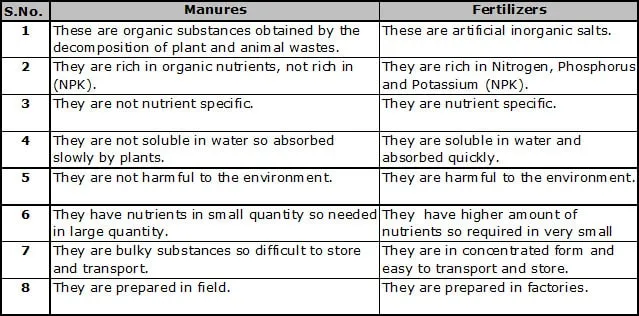
f)Classification of plant nutrients :
There are 16 essential elements for growth and development of plants. They are classify into two grops
1. Macro nutrients : These are required in large quantity.
e.g - Carbon, oxygen, hydrogen, nitrogen, phosphorus, potassium, sulphur, calcium, magnesium.
2. Micro nutrients : These are required in trace amount.
e.g - Iron, manganese, boron, zinc, copper, molybdenum, chlorine.
Review Questions
1. What are the advantages of manure?
2. Write the name of frame work elements.
3. What are macronutrients and micronutrients?
4. What are the various ways by which soil can be enriched? Explain.
5. What is green manure?
6. What are biofertilizers?
7. What do you understand by field fallow?
(2) SOWING
The process of putting the seeds in the soil is known as sowing. Before sowing good quality (healthy and good variety) seeds are selected.
a) Selection of seeds : For separating healthier seeds from a mixture of healthy and weak seeds, the seeds are placed in water. Healthy seeds sink and weak
or insect eaten seeds float on water. Healthy seeds are separated and dried before sowing.
b) Sowing can be done by :
(i) Broadcasting : Seeds are sown by hand or manually.
(ii) Traditional tool : The tool used traditionally for sowing seeds has shape like a funnel. The seeds are filled into the funnel, passed down through two
or three pipes having sharp ends. These ends pierce into the soil and place seeds there.
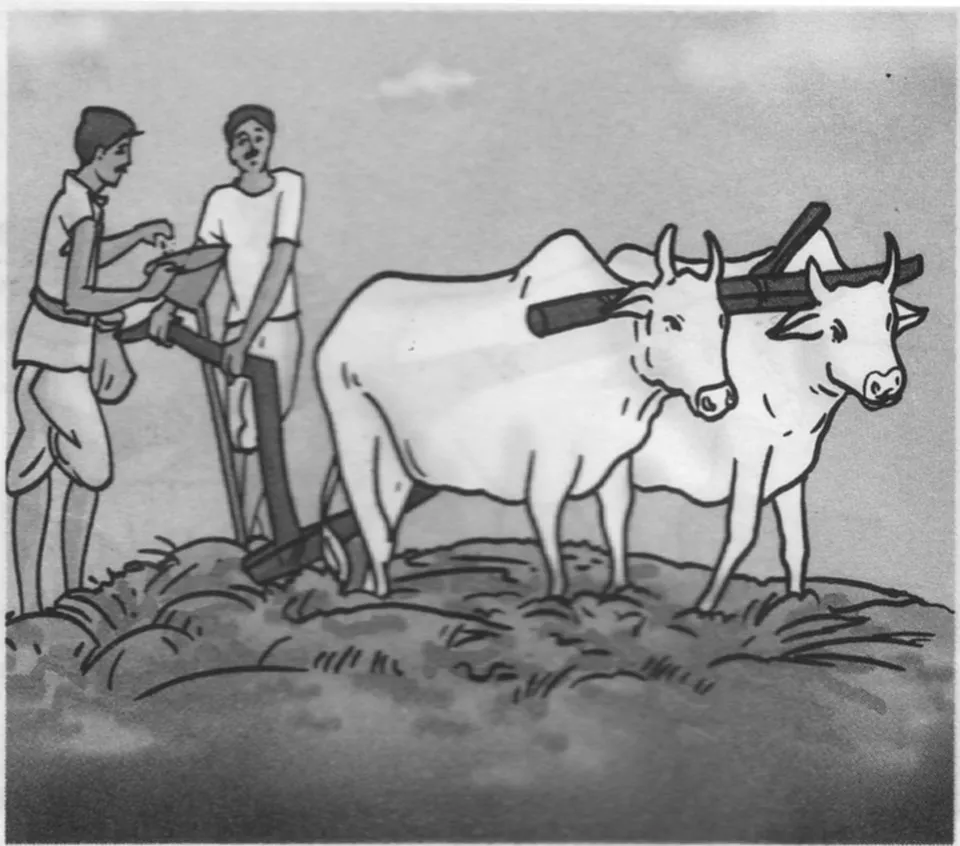
Traditional method of sowing
(iii) Seed drill : Seeds are sown by the seed drill with the help of tractor. It saves time and labour.
* Precautions during sowing seeds.
1 Use good quality, healthy and disease free seeds.
2.The seeds are sown at a particular depth under the soil. Seeds left on the surface of the soil may be carried or destroyed by the insects and the birds.
Seeds placed deep into the soil may either fail to germinate or may fail to come out into the air on germination.
3. Distance should be proper to avoid overcrowding.
4. Enough water should be there in the soil.
DO YOU KNOW?
* Transplantation : Firstly seeds are sown in nursery and then seedlings are shifted to the main field. This process is known as transplantation. It
enables the farmers to select the healthier seedlings.
eg.– Rice, Onion, Tomato, Brinjal and Chilli.
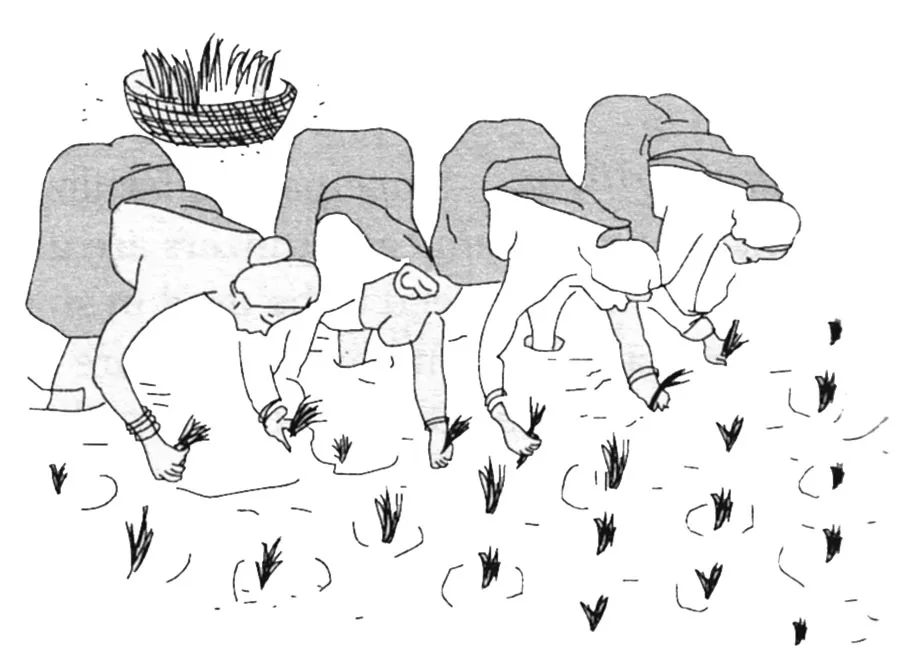
Transplantation
Review Questions
1. Explain why seeds should be sown at the right depth.
2. Name the crop which is sown by transplantation.
3. Define transplantation.
4. What precautions we need to observe while sowing seeds?
5. Why do we need to keep requisite distance between two adjoining plants?
(3) IRRIGATION: The process of artificial supplying of water to crop at different intervals is called irrigation. The time and frequency of irrigation varies from
crop to crop, soil to soil and season to season.
Sources of irrigation : Well, tube well, ponds, lakes, river, canal and dams.
Methods of irrigation : Surface irrigation : In this type of irrigation the water is lifted from lake, well and canal by using following traditional ways like
moat (pulley system), chain pump, dhekli, rahat (lever system).
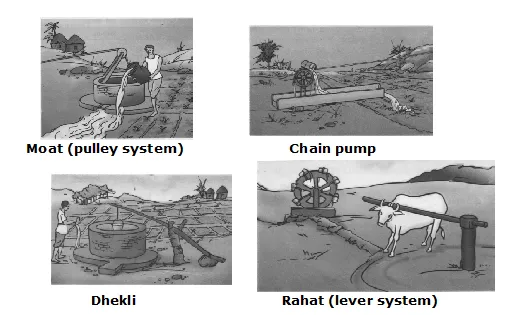
1.These methods are cheaper and less efficient.
2. These methods require cattle and human labour.
3· The lifted water is allowed to run over the field. Surface irrigation can be subdivided into furrow and basin irrigation.
Furrow irrigation : The water is allowed to run through furrow between the ridges.
Basin irrigation : The field is flooded with water by mating bunds all around it.
* Disadvantages of traditional ways of irrigation :
1.They require more human labour and human efforts.
2. They are less efficient so water is wasted in large quantity.
3. They are not useful for poor water regions.
Nowadays the following modern ways of irrigation are used.
(i) Sprinkler system :–
In this system the perpendicular pipes having rotating nozzels on top, are joined to main pipe line at regular intervals.
1. It spreads water uniformly over crop plants and field.
2. This method is useful for sandy soil and uneven land.
3. It is an efficient system in the canal irrigated area of Haryana and Rajasthan.
Sprinkler System
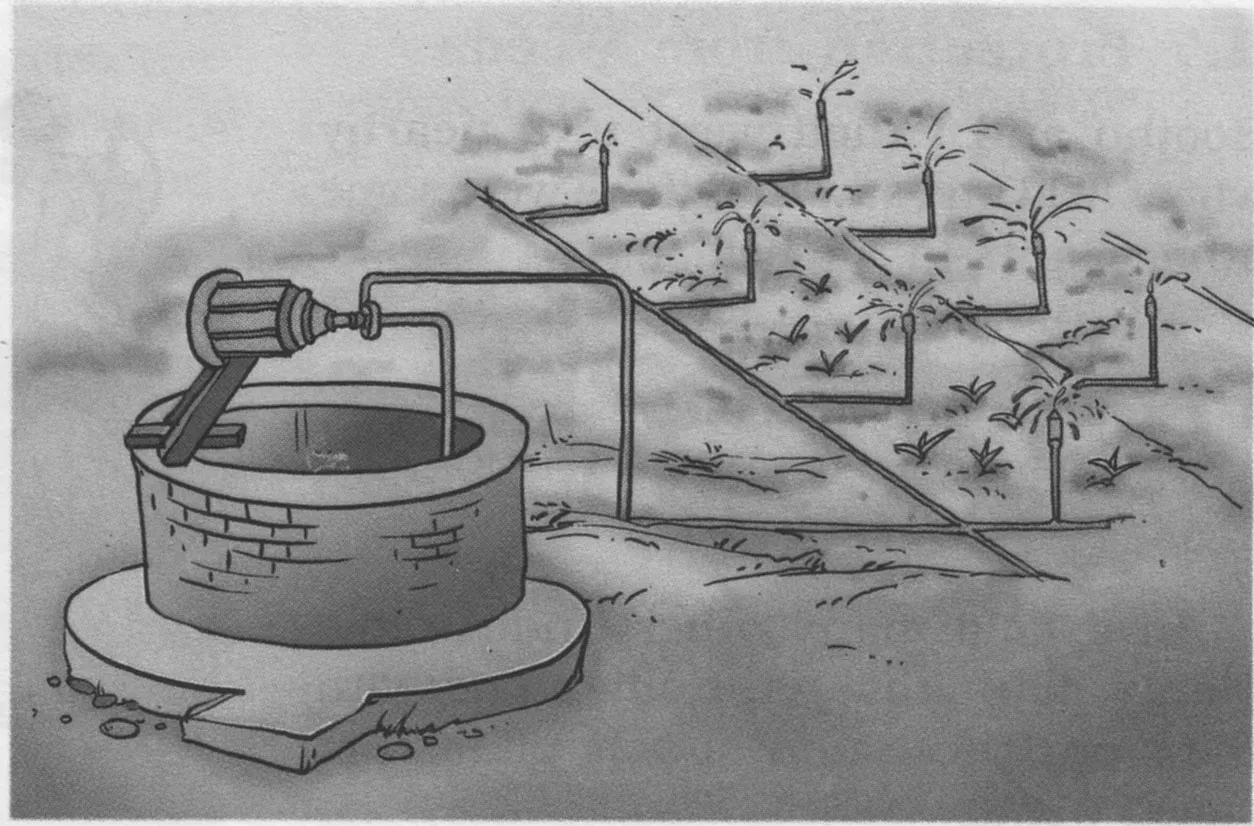
(ii) Drip system or trickle irrigation :
1· It involves the use of pipes fitted with small tubes called emitters. The pipes are laid over or under the soil and emitters release water drop by
drop around the roots of the plants.
2. In this method water is not wasted at all.
3. This method is a boon in poor water regions.
4. This is the best irrigation technique for fruit crops, garden and trees.
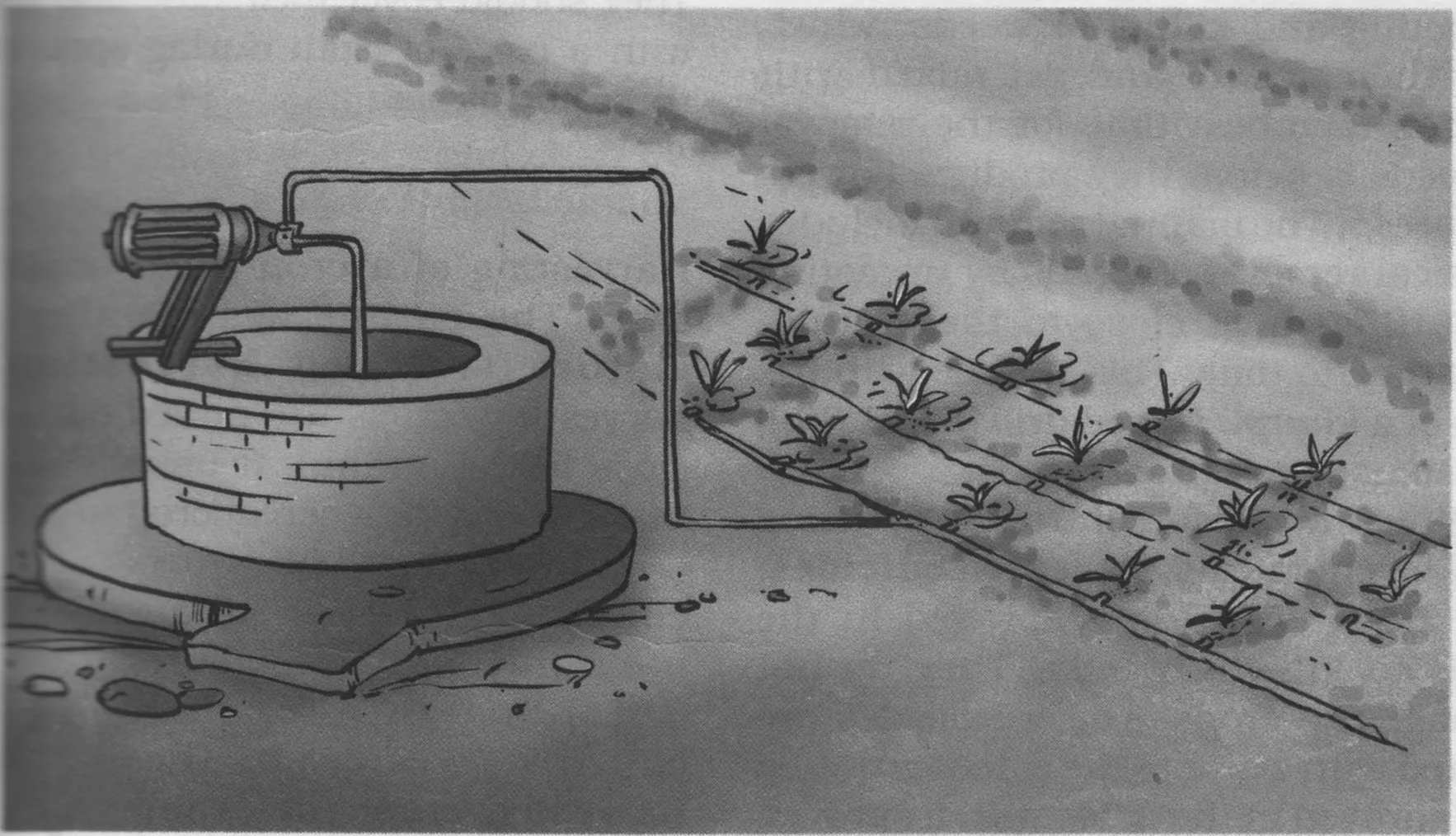
Drip System
DO YOU KNOW?
* Other irrigation systems in India.
(i) Canal system : Canals receive water from the rivers. The main canals are divided into branches which are further divided into distributaries to cover
maximum areas for irrigation.
(ii) Tanks : Tanks are water storage reservoirs which store the run off water of small catchment area.
(iii) 
(iv) River valley system : Due to heavy rainfall, many river valley are found in Western Ghats and Karnataka. This results in higher run off and discharge
flows in the rivers. To prevent this coffee, rubber, coconut are cultivated on the slopes of these valleys and single rice crop is grown at bottom.
(v) River lift system : Water is directly drawn from the river using pumps.
*Advantages of irrigation :
1. It maintains the moisture of soil.
2. It helps in germination of seeds.
3. It helps in supply of essential nutrients.
4. Nutrient dissolved in water get transported to each part of plant.
5. It helps in growth of plants.

(4) WEEDING: Removal of weeds or undesirable plants is called weeding. It can be done by khurpa (trowel) and Harrow.
Weed : They are unwanted plants which grow along with a cultivated crop in a field. They can severely reduce crop yields by competing
for light, water and nutrients.
Some common weeds : Parthenium (Gajar grass), Convolvulus, Amaranthus (Chaulai), Chenopodium (Bathua), Xanthium (Gokhroo) and Dandelions.
* Methods of weed control
(a) Mechanical control : It can be done by ploughing, burning and cutting of weeds before they produce flowers and seeds.
(b) Chemical control : It can be done by spraying weedicides or herbicides (chemical which are used to kill the weeds).
e.g. 2, 4-D, 2, 4, 5-T, MCPA, Butachlor & Atrazine.
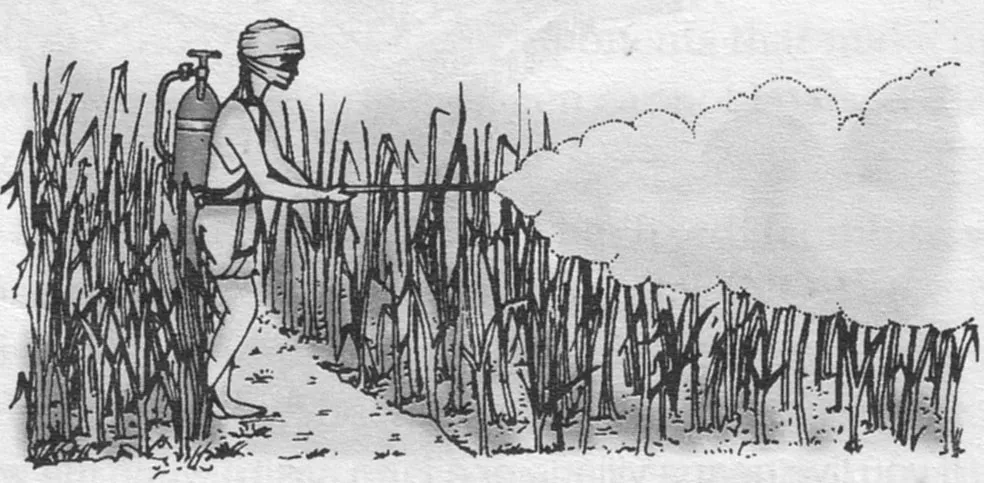
Spraying weedicide
(c) Biological control : It is done by living organisms to destroy weeds.
e.g Cassia plant prevents the growth of Parthenium weed.
e.g. Herbivorous fish (Carps) feeds on aquatic weeds (Hydrilla).
* Advantages of biological control :
· It does not cause pollution.
· Organisms are harmless to the main crop.
* Crop protection management : It includes eradication of pest, pathogens and other organisms that are harmful to the crop plants.
Pest : Organism which damage or destroy cultivated plants or plant products is called pest.
eg.– Insects, rats, mites and microorganisms.
Pathogen : Disease causing organism is called pathogen.
eg.– Bacteria, Fungi and Virus.
* Diseases of crop :
(i) Seed born : Spread through seeds and caused by fungi.
eg. Ergot of bajra.
(ii) Soil born – Spread through soil.
eg. – Smut of bajra.
(iii) Air born : Spread through air, eg. – Rust of wheat.
(iv) Water born : Spread through water. eg. – Bacterial blight of rice.
* Pesticides or Biocides : These are chemical substances used to kill, control or repel pest.
Types of pesticides :

* Advantages of pesticides : They kill pest quickly, increase food production and are easy to store.
* Disadvantages of using pesticides :
1. They cause soil and water pollution.
2. Residue left on the fruits & seeds is harmful for human consumption.
3. They destroy even the useful insects.
* Preventive measures avoiding use of pesticides :
1. Crop rotation, multiple cropping and field fallow.
2. Sowing healthy seeds and summer ploughing.
3. Use of pest and disease resistant hybrid varieties of crop plant.
4. Field also need to be protected by grazing animals by raising wire fences and boundary wall.
5. Birds are scared away by raising scarecrows and beating of drums.
Review Questions
1. What is fertigation?
2. What is irrigation?
3. What is surface irrigation?
4. Which type of soil requires more water for irrigation?
5. Mention three ways of removing weeds from the crop field.
6. Write the names of two common weeds found in the field.
(5) HARVESTING: The cutting and gathering of crops after its maturation is called harvesting. It can be done manually by sickle or by a machine called harvester.
1. Many festivals are associated with harvesting season such as Baisakhi, Bihu, Onum, Pongal, Holi, Diwali.
2. Many crops require special harvesting machines. Cotton strippers (for cotton), corn pickers or huskers
(for corn)
3. Fruits and vegetables are generally hand-picked when ripe.
(6) THRESHING: The process of beating out the grain from the crop is called threshing. It can be done by threshers.
(7) WINNOWING : The process of separating the grains from the chaff is called winnowing.
1. In this process, the grain-chaff mixture is gradually dropped on the
ground from a height.
2. The heavier seeds fall vertically down, while lighter chaff is blown
away by wind.
Winnowing
(8) STORAGE: Proper storage is necessary to get seasonal food regularly throughout the year. Freshly harvested grains have more moisture. If freshly harvested
grains are stored without drying, then they may get spoil and lost their germination capacity. Hence before storing them the following precautions must be undertaken.
* Precautions :
a) Grains should be safe from moisture, insects, rats, and microorganisms.
b) Grains must be properly dried in the sun to reduce the moisture in it.
c) Grains must be srtore in jute bags or metallic bins.
d) Store grains in silos, granaries and godown with chemical treatment to protect them from pests.
e) Dried neem leaves can be used for storing food grains at home.
* Factors affecting stored food :
(i) Biotic factors : e.g. insects, micro-organisms, mites, birds, rodents and other animals.
(ii) Abiotic factors : e.g.moisture, humidity and temperature.
DO YOU KNOW?
a) Buffer stock : Surplus stock of grains which is preserved for emergencies like drought and floods is called buffer stock.
b) Food grains are stored in large godowns by agencies like Food Corporation of India (FCI) and state warehousing corporations.
c) Fruits and vegetables which have high water content are stored at 0°C to 1°C temperature.
d) Drying, canning and freezing are some of the methods of crop preservation.
e) Drying reduces the moisture content, canning prevents the microbial growth and freezing reduces the rate of respiration of microbes.
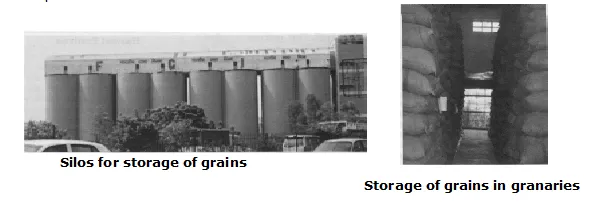
Silos for storage of grains Storage of grains in granaries
Review Questions
1. What is harvesting?
2. Name some harvest festivals.
3. How is threshing done?
4. Define the term winnowing.
5. How does a farmer store the grains?
6. What factors may be responsible for loss of grains during storage?
CROP IMPROVEMENT
* Green revolution :– Yield of crop per hectare greatly increased due to the use of genetically improved variety of seeds.
a) Developed new varieties of rice, wheat and maize increased food production of India.
b) The desirable superior character in a variety can be incorporated through various methods of genetic improvement of crops like plant breeding and genetic engineering.
* Plant breeding : The science of improving crop varieties is called plant breeding. These involve introduction, selection of plant and than hybridization.
DO YOU KNOW?
Important plant breeders :
1. N.E. Borlaug – A maxican plant breeder who was awarded Nobel prize (1970) for developing high yielding varieties of wheat Sonara-64 and
Lerma roja-64 [Father of green revolution]
2. Dr. M.S. Swaminathan – He has produced Sharbati sonara a variety of wheat by mutation which is responsible for green revolution in India. [Father of green revolution in India]
* Hybridization : The process of crosss breeding between two geneticaly dissimilar individuals is called hybridization. This process helps to produce
hybrid variety with desirable characteristics.
* Objects of plant breeding : Higher yield, Better quality, Blotic and abiotic resistance, Change in maturity duration, Wider adaptability, Desirable agronomic characteristic.
* Genetic engineering : The transfer of one or more genes (DNA fragments) from one plant to another is called genetic engineering. The plant in which the
foreign gene has been introduced is called transgenic plant or genetically modified plant.
* Cropping patterns : Different ways of growing crops can be adopted to get maximum benefit.
(a) Mixed cropping : The growing of two or more types of crops on same field is called mixed cropping. The products and wastes from one crop can
stimulate the growth of other crop in it.
(b) Intercropping : The growing of two or more crops grown in a definite row pattern is called intercropping.
(c) Crop rotation : The process in which different crops are grown alternately in the same field is called crop rotation.
COMMON DISEASES OF CROPS
Crop plants can be destroyed by a variety of disease causing organisms. The crop diseases can be divided into four major categories.
(i) Seed borne diseases: Caused by fungi generally and spread through seeds. e.g. Ergot of bajra.
(ii) Soil borne diseases: Spread through soil. e.g. Smut of bajra.
(iii) Air borne diseases: Spread through air. e.g. Rust of wehat.
(iv) Water borne diseases: Spread through water. e.g. Bacterial blight of rice.
ANIMAL HUSBANDARY
* Animal husbandry : The branch of agriculture that deals with the feeding, caring and breeding of domestic animals is called animal husbandry.
The main elements of animal husbandry are
(i) Proper feeding (ii) Providing good shelter
(iii) Proper health (iv) Proper breeding
1. CATTLE FAR MING 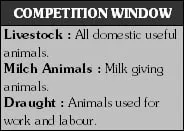
Cattle husbandry is done for two purposes, milk production
and draught labour for agricultural work like tilling and
irrigation.
Cattle feed consists of two components :
(i) Roughage : It contains large amount of fibre which includes hay fibre silage, fodder and legumes like barseem, lucrene and cowpea.
(ii) Concentrate : It is a mixture of cereals like maize, oat, barley, jowar, grams, rice polish, cotton seeds, gram bran, molasses and
oilseed cake moistened in water. These are rich in proteins, highly palatable and easily digestible.
DO YOU KNOW?
1. Milch breeds of indegenous cows : Gir, Sahiwal, Tharparkar.
2. Milch breeds of exotic cows : Jersey, Brown-swiss.
3. Cross breeds of cows : Karan-swiss, karan-fries.
4. Breeds of Indian buffaloes : Murrah, Mehsana, Surti, Nagpuri.
2. Poultry : The rearing and caring of birds for obtaining eggs and 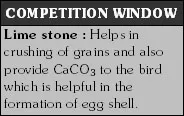
meat for the commercial purpose is known as poultry farming.
a. It includes chickens (fowls), ducks, geese, turkeys, guinea-fowls,
peafowls, pigeons and guails.
b. The egg laying poultry birds are called egger or layer, while the one
reared for obtaining meat is called chicken or broiler.
c. Feeding : They feed grains, green manure and lime stones.
d. Broody Hen : Hen after laying eggs, sits on them for about 21 days, till the chickens hatch out.
This time period is known as incubation period. During this time. the hen becomes aggressive if anyone disturbs it. It is called a broody hen.
DO YOU KNOW?
Breeds of Hens
Indegenous Breeds : Aseel, Brhama.
Excotic Breeds : White Leghorn, Rhode Island Red.
Cross Breeds : HH260, B77.
3. FISHERIES: The rearing of fish on a large scale is called pisciculture. 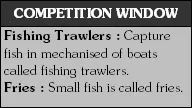
a. The fish eggs are introduced into small ponds called hatcheries.
b. Fish is a rich source of proteins and oils. These are a good source
of vitamin A and vitamin D.
c. Fresh water Fishes : Catla, Rohu and Mrigal.
d. Marine Fishes : Tuna, cod, pomfret.
* In hatcheries fries hatch out of eggs which are transferred to a larger culture pond where they get proper food, light and oxygen. The fishes
are harvested when they attain the required size.
4. APICULTURE: The rearing of honey bees for a large scale production of honey and bee wax, is know as apiculture.
a. Bees are reared in wooden boxes for commercial production of honey called apiaries.
b. Honey bee colony and social organization : 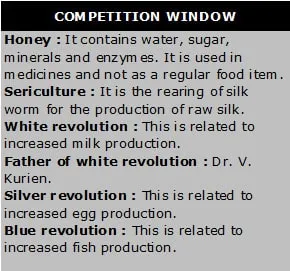
In a colony, there are three types of bees which are
structurally and functionally different from one another,
so polymorphism is associated with division of labour.
These types are :
(i) Queen bee : Queen bee lays eggs which hatch
into larvae, which grows into pupae.
(ii) Drones bee : Drones are smaller in size than the
queen, and their function is to fertilize
the queen.
(iii) Workers bee: Workers bees look after young ones,
collect nectar and pollen from
flowers and make honey.

NCERT QUESTIONS WITH SOLUTIONS
Q.1 Give two example of each
(a) Kharif crop (b) Rabi crop
Ans. Kharif crop (Rice, maize), rabi cro (wheat, gram)
Q.2 Write a paragraph in your own words on each of the following:
(a) Preparation of soil (b) Sowing (c) Weeding (d) Threshing
Ans. (a) Preparation of soil: Preparation of the soil involves loosening and turning the soil.
This process is known as ploughing, is done by using a wooden or iron plough which pulls the soil. The pulled soil is then levelled by using a wooden or iron leveller.
(b) Sowing: Seeds are sown after preparation of the soil. Seeds can be sown manually or by seed drills by
the process called broadcasting. Seeds should be sown at the correct depth and at correct distance.
(c) Weeding: The process of removing weeds from a field is called weeding.
Weeding can be done manually by pulling the weeds out by hand or by using a harrow to uproot them
. Weeding can also be done by spraying special chemicals called weedicides.
(d) Threshing: The process of separating the grains from the cut crop, known as threshing.
Threshing can be done manually by making oxen or buffaloes trample over the cut crop or by using a machine called thresher.
Q.3 If wheat is sown in the Kharif season, what would happen? Discuss.
Ans. The farmer will not get a good crop because wheat should be sown in winter season.
Q.4 Explain how soil gets affected by the continuous plantation of crops in a field.
Ans. When the crops are planted continuously in a field, the soil becomes deficient in nutrients.
Q.5 What is irrigation? Describe two methods of irrigation which conserve water.
Ans. Supply of water to crops at appropriate intervals is called Irrigation.
Two methods of irrigation are:
(i) Sprinkler system - Where it sprinkles on the crops as if it is raining.
(ii) Drip system - In this system, the water falls drop by drop just at the position of the roots.
Q.6 Arrange the following boxes in proper order to make a flow chart of sugar cane crop production:
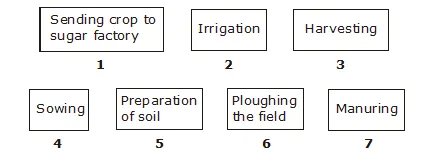
Ans. 1. Preparation of soil
2. Ploughing the field
3. Sowing
4. Irrigation
5. Manuring
6. Harvesting
7. Sending are different from manure
Q.7 How fertilizers are different from manure?
Ans.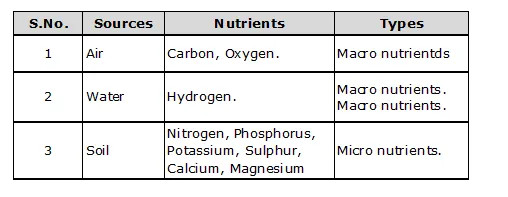
Q.8 What are weeds? How can we control them?
Ans. They are unwanted plants which grow along with a cultivated crop in a field. There are several methods to control weeds like:
(a) Mechanical methods (b) Chemical methods (c) Biological methods
EXERCISE - I
Q.1 What are manures and fertilizers? Give examples.
Q.2 Why do we need to protect crops from pathogens?
Q.3 What are the two main crop seasons? Give three examples of the crops grown during each season.
Q.4 Define irrigation. Discuss its importance and the various ways in which water is supplied to the fields.
Q.5 What is weeding? Discuss the different methods of weeding.
Q.6 Write differences between fertilizers and manure.
Q.7 How are fish reared in tanks?
Q.8 Write a paragraph in your own words on each of the following:
(a) Hoe (b) Crumbs
(c) Manure (d) Harvesting
Q.9 How is our food production or crop yield increasing day by day?
Q.10 How is the population of insects and microorganisms controlled in stored foodgrains?
Q.11 How are pests controlled in a crop field?
Q.12 Why proper storage of food grains is important? How is it done?
EXERCISE - II
Q.1 Which of the following should come in the box 'X' in the given sequence ?
Ploughing ® Levelling ® manuring ® Sowing seeds ®
(A) Broadcasting (B) Transplanting (C) Irrigation (D) Drilling
Q.2 Which of the following crops would enrich the soil with nitrogen ?
(A) Apple (B) Pea (C) Paddy (D) Potato
Q.3 Eutrophication means :
(A) toxication of water by fertilisers (B) decrease the growth of algae
(C) increase in the fertility of the soil (D) all of the above
Q.4 Besides carbon, hydrogen and oxygen, the synthesis of proteins by plants require :-
I. Magnesium II. Nitrogen III. Potassium
(A) I only (B) III only (C) II only (D) II and III only
Q.5 Nitrogen-fixing bacteria can be found in :-
I. the soil II. root nodules III. leaves
(A) I only (B) I and II only (C) II and III only (D) I, II and III
Q.6 Which of the following crops seedlings need to be transplanted ?
(A) Wheat (B) Potato (C) Mustard (D) Rice
Q.7 Identify the correct sequence in farming :-
(A) Sowing ® tilling ® irrigation ® manuring (B) Sowing ® tilling ® manuring ® irrigation
(C) Tilling ® sowing ® irrigation ® manuring (D) Tilling ® sowing ® manuring ® irrigation
Q.8 Which of the following parts have bacteria in the figure given below ?
(A) K (B) L (C) M (D) N
Q.9 Grain stocked for emergencies is called :-
(A) surplus stock (B) storage (C) buffer stock (D) regular
Q.10 The crop that requires more irrigation is :-
(A) wheat (B) rice (C) maize (D) jowar
Q.11 Operation flood is otherwise called :-
(A) green revolution (B) white revolution (C) black revolution ( D) yellow revolution
Q.12 Match the following with correct answers :-
a. Kharif crops I. Wheat
b. Rabi crops II. Ploughing
c. Tilling III. Harvesting
d. Combine IV. Paddy
(A) a - I, b - II, c - III, d - IV (B) a - IV, b - I, c - II, d - III
(C) a - IV, b - III, c - II, d - I (D) a - III, b - IV, c - I, d - II
Q.13 To prevent seed-borne diseases the seeds must be :-
(A) sown at right depth (B) spaced at right depth
(C) sown in highly wet soil (D) treated with fungicide solutions
Q.14 Horticulture deals w ith –
(A) Production of crops (B) Breeding of animals
(C) Study of soil (D) Production of fruits and vegetables.
Q.15 Which one of the following is not true about ploughing –
(A) Loosens the soil (B) Aerates the soil
(C) Makes the soil hard (D) Allows easy penetration of roots into the soil
Q.16 Separating the grain from chaff is called –
(A) Winnowing (B) Hybridisation (C) Threshing (D) Harvesting
Q.17 Organic substances obtained from the decomposition of dead plants and animals wastes are called–
(A) Fertiliser (B) NPK (C) Herbicide (D) Manure
Q.18 Biological methods of pest control involve –
(A) Spraying chemicals to kill plants (B) Killing pests by using other organisms
(C) Spraying DDT (D) Weeding
Q.19 Which one of the following is not a method to maintain the fertility of soil.
(A) Crop rotation (B) Multiple cropping
(C) Fallow method (D) Ploughing
Q.20 Which one of the following can be used to prevent the disease called rust in wheat?
(A) An insecticide (B) A rodenticide
(C) A fungicide (D) A herbicide
Q.21 Which of the following machines would you use to harvest a crop as well as to beat out the grains from the chaff?
(A) Mechanical harvester (B) Combine
(C) Thresher (D) Harrow
Q.22 Denitrifying bacteria givea out –
(A) Carbon (B) Nitrogen (C) Oxygen (D) Hydrogen
Q.23 Plants get their nitrogen from the soil as –
(A) Nitrates (B) Nitrogen dioxide (C) Nitrogen oxide (D) Nitric acid
Q.24 First cultivated crop plants were –
(A) Cereal crop (B) Pulses (C) Fodder crop (D) Fibre crop
Q.25 Transplantation is –
(A) Process of scattering the seed.
(B) Process of loosening and turning of soil
(C) Process of shifting of tiny saplings from the nursery to a field
(D) None of these
Q.26 Which preventive measure(s) avoid use of pesticides –
(A) Crop rotation (B) Use of pest resistant varieties of crop plant
(C) Summer ploughing (D) All of these
Q.27 Chemical substances which are used to kill insects –
(A) Fungicide (B) Insecticide
(C) Weedicide (D) All of these
Q.28 Process of cutting of crop after its maturation–
(A) Threshing (B) Harvesting
(C) Winnowing (D) None of these
Q.29 Which of the following is not a method of irrigation?
(A) Drip irrigation (B) Sprinkler
(C) Nursery (D) Canals
Q.30 The unwanted wild plants growing along with the crop plants are called –
(A) Seedlings (B) Weeds (C) Minor crops (D) Grasses
Q.31 Vermicomposting involves –
(A) Cockroach (B) Earthworm (C) Leech (D) Roundworm
Q.32 The science of improving crop varieties is called–
(A) Plant breedling (B) Hybridization (C) Selection (D) Introduction
Q.33 Which one of the following cause(s) plant diseases?
(A) Viruses (B) Bacteria (C) Fungi (D) All of these
Q.34 The big pieces of soil in the polughed field are called –
(A) Crumbs (B) Flakes (C) Lumps (D) All of these
Q.35 Rearing and breeding of fish in pond and tank is called –
(A) Aquaculture (B) Fishing (C) Pisciculture (D) Apiculture
Q.36 Broilers are maintained for getting –
(A) Milk (B) Egg (C) Meat (D) Leather
Q.37 Males of honey bee colony are called –
(A) Drone (B) Workers (C) Soldiers (D) All of these
Q.38 Cattle feed should contain –
(A) Roughage (B) Concentrate (C) Both (D) None of these
EXERCISE -III
Section-A
· Fill in the blanks
1. If a chemical is used to kill locusts and termites it is called an __________.
2. Grains are separated from the chaff and hay by a method called __________.
3. __________ loosens up the soil, to prevent the soil from being eroded it is __________.
4. __________ are prepared by decomposition of organic matter. Where as __________ are mineral salts made by human.
FILL IN THE BLANKS(Multiple choice)
5. When we put seeds in ______.Some seeds will float while other will sink. As damaged seeds become _______& thus lighter, as a result of which they will float.
While seeds of good quality will sink as they are filled with nutrients
(A) Acid, hollow (B) Water, hollow (C) Milk, Hollow (D) Water, areated
Section-B
· Multiple choice questions with one correct answer
1. Which one of the following is not true about ploughing?
(a) Loosens the soil (B) Aerates the soil
(C) Makes the soil hard (D) Allows easy penetration of roots into the soil.
2. Organic substances obtained from the decomposition of dead plants & animal wastes are called :
(A) Fertiliser (B) NPK (C) Herbicide (D) Manure
3. Which one of the following can be used to prevent the disease called rust in wheat?
(A) An insecticide (B) A rodenticide (C) A fungicide (D) A herbicide
4. Before storage, Excess ............. must be removed from food grain :
(A) Soil (B) Moisture (C) Air (D) Seed
Section-C
· Assertion & Reason
Instructions: In the following questions as Assertion (A) is given followed by a Reason (R). Mark your responses from the following options.
(A) Both Assertion and Reason are true and Reason is the correct explanation of ‘Assertion’
(B) Both Assertion and Reason are true and Reason is not the correct explanation of ‘Assertion’
(C) Assertion is true but Reason is false
(D) Assertion is false but Reason is true
1. Assertion : Manures are organic nutrients where as fertilisers are inorganic nutrients.
Reason : Plant take nitrogen from the soil in the form of nitrate.
Section-D
· Match the following (one to one)
Column-I and column-II contains four entries each. Entries of column-I are to be matched with some entries of column-II. Only One entries of column-I
may have the matching with the some entries of column-II and one entry of column-II Only one matching with entries of column-I
1. Column I Column II
(A) 2, 4 - D (P) Fungicide
(B) NPK (Q) Rodentide
(C) Mice (R) Weedicide
(D) Rust (S) Fertiliser
EXERCISE - IV
Section-A
· Multiple choice questions with one correct answer
1. Organism refered as farmer’s friend :
(A) Buffalo (B) Cow (C) earthworm (D) none
2. An important rabi crop is :
(A) Maize (B) Soyabean (C) Cotton (D) Wheat
3. Paddy are transplanted. It means :
(A) There seeds are directly put into soil.
(B) They are grown on barren land.
(C) They are first grown in nursery & then moved to the field.
(D) They produce flower.
4. Ammonium sulphate is a :
(A) Weedicide (B) Herbicide (C) Fertiliser (D) None
Section-B
· Multiple choice questions with one or more than one correct answers
1. True about harvesting is that :
(A) It is cutting of the mature crop (B) It is done by machines or manually
(C) It is rearing of animals (D) It is supply of water.
2. Storage requires :
(A) Less moisture (B) Silos (C) Moat (D) Rhizobium
Section-C
· Comprehension
Following flow chart is of nitrogen cycle that is an important biogeochemical cycle. Read it carefully & answers following questions.
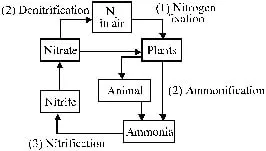
1. The sequence of Nitrogen cycle is :
(A) Plant, Ammonia, Nitrate, Nitrite (B) Plant, Animal, Ammonia, Nitrite
(C) Ammonia, Animal, Nitrite, Nitrate, (D) Nitrite, Nitrate, Ammonia, Plant
2. Nitrogen is a part of :
(A) Carbohydrate (B) Protein (C) Fat (D) None
3. Nitrogen from plant move to animal through :
(A) Air (B) Water (C) Soil (D) Food.
Section-D
· Match the following (one to many)
Column-I and column-II contains four entries each. Entries of column-I are to be matched with some entries of column-II. One or more than one entries
of column-I may have the matching with the some entries of column-II and one entry of column-II may have one or more than one matching with entries of column-I
1. Column I Column II
(A) Moat (P) Traditional method of irrigation
(B) Sprinkler (Q) Liver System
(C) Rahat (R) Modern method of irrigation.
(D) Drip system (S) Pulley system.
Answers
Exercise-III
Section-A
1. Insecticide 2. Winnowing 3. Ploughing, Levelled
4. Compost, Fertilizers
Section-B
1. (C) 2. (D) 3. (C) 4. (B)
Section-C
1. (B)
Section-D
1. (A)-(R), (B)-(S), (C)-(Q), (D)-(P)
Exercise-IV
Section-A
1. (C) 2. (D) 3. (C) 4. (C)
Section-B
1. (A,B) 2. (A,B)
Section-C
1. (B) 2. (B) 3. (D)
Section-D
1. (A)-(P,S), (B)-(R), (C)-(P,Q), (D)-(R)